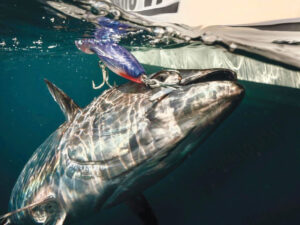
slow action casting
If someone were to inventory an inshore saltwater fly-fisherman’s rod collection, he would probably find an abundance of 9-foot fast- or super-fast-action rods. If the rods were manufactured within the last decade, they would more than likely be very lightweight. That trait would come from the extra-high-million-modulus graphite or graphite blend that matches the rod’s speed. And with today’s advanced technology, the rods would probably be three, four or more sections. Gone are the days when a multipiece fly rod paled in casting comparison to a two-piece rod.
Did high line speed as a casting technique come first, followed by the corresponding super-fast-action high-million-modulus graphite rods? Or were the rods developed first, followed by the high-line-speed casting technique? It doesn’t really matter. My question is: Are there applications for slow- or medium-action lower-million-modulus graphite rods in the brine? I think there are.
For a long time, the theory of fly-fishing in the salt was that by casting far, anglers would be able to reach the fish. A side benefit came in the form of prospecting. If there wasn’t a pod of fish close to the horizon, a long cast would cover more water and therefore give an angler a greater likelihood of hooking up.

Slow- to Medium-Action Advantages
Recently I used one of my very old rods on a beach near my home. I was fishing the September full moon with a Shakespeare Wonderod, the 930 Professional to be exact. This 9-foot-6-inch model was designed to cast a GBG line, which in today’s terms would be a DT9F. The rod alone weighs 7 ounces, and when an appropriate-size large-arbor reel is added, the outfit is quite heavy. Casting isn’t as high a priority with this type of rod, but fishing clearly is. Using high line speed with repetitive false casts was tiresome with such a heavy setup, so I needed a different approach. Here’s why the outfit worked.
With a tapered line matched appropriately to the rod, I needed only one or two water hauls, combined with a line shoot, to dump the entire line.
When fish followed up but didn’t eat, it was simple to get the fly back in front of them with a water haul, a roll-cast pickup and a single haul.
I could spend more time with the line, and therefore the fly, in the water, which resulted in more hookups.
The casting stroke was slower and more relaxed.
It was easier to mend and properly control the line, which was particularly important when fishing in murky water or swinging flies in current.
I’ve always preferred slow to medium action in my fly rods because it feels good. Subsurface work is a joy, fishing under the moonlight is a breeze, and even a small fish put up a tip-to-grip type of fight. Lower-million-modulus graphite rods break with far less regularity than the super-stiff super-light versions.
Rhode Island angler Kenney Abrames is a huge fan of slow-action rods. In his free Tuesday fishing sessions, as well as during his seasonal fly-rod tuneups, Abrames matches a wide variety of fly-line tapers with rod types.
“Traditional cane rods, and then fiberglass rods, load easily and are invaluable for mending and proper line control,” says Abrames. “Because of the expansiveness of the ocean and diverse currents, saltwater line mends tend to be greater than they are in fresh water. Longer, more supple rods can mend short amounts of line when necessary but really excel when lifting long lengths of line in the bigger environment of salt ponds, onshore bars and beachfronts. They also do well in rock gardens, rips or ledges.”
Abrames designed a switch rod called a Salmo Saxtilis. I recently took the 10½-foot model No. 2, which is a 42-million-modulus graphite rod, to the Bahamas. Considering the stick’s steep front taper, Abrames is a big proponent of using RIO Outbound line, and I paired the rod with an 8-weight Outbound. What I found while wading the flats was the same thing I saw on the Cape Cod, Massachusetts, beach near my home: When a fish turned off the fly, it was easy to make one false cast and reposition the fly in front of the fish.
Softer rods make for a thoroughly enjoyable night-fishing experience. Since sensitivity runs deep into the rod butt, anglers can detect the most subtle of bumps, hits and takes. If you’re fishing the dark of the moon in the Northeast, you’ll particularly appreciate the tactility. The feeling that signals a take is oftentimes the difference between fishing and catching.
If you’re interested in trying a slow- or medium-action rod in the salt, you’re in luck. The used-rod market is chockablock with older models. You can find them at any of the online auction houses, like eBay and such. If you’re really looking to go old school, cane salmon and steelhead rods are readily available, particularly in longer lengths. If you’re ever in Rhode Island, stop by one of Abrames’ Tuesday-night fishing programs. You can borrow a rod and watch him cast the entire length of line with one hand in his pocket.
Slow-Action Casting Tips
When casting a slow- to medium-action rod, you will need to turn back time to the era of rotary-dial phones. Here are three tips to keep in mind.
1] Life was slower before the technology revolution. When casting a slow- to medium-action rod, you’ll need to slow down your stroke. Let the rod load and unload; that is the key to maximizing its power.
2] Focus your casting stroke. Too wide a stroke won’t allow for a proper load; neither will too short a stroke. You’ll be able to feel the rod load and unload very easily, so look for that sweet spot in the stroke. A tactile approach most times works better than a visual approach.
3] Reduce the number of false casts. Softer, slower rods are designed to do the work for you.








